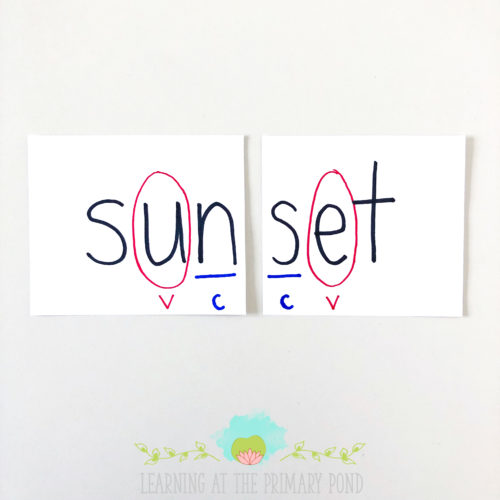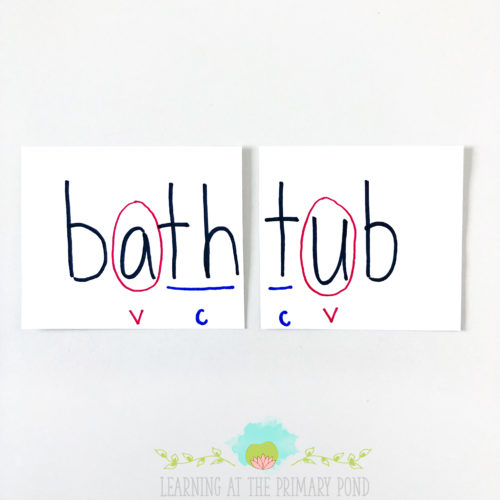The 6 Syllable Types
Do you know the 6 syllable types? They are:
- Closed 闭音节
- Open 开音节
- Vowel-Consonant-E (also known as Magic E or Silent E) 相对开音节
- Vowel Team 元音字母组合
- R-Controlled R音节
- Consonant-L-E 成音节
Finding the Number of Syllables in a Word
An important first step in dividing up a word into its syllables is knowing how many syllables the word has.把一个词分成音节的第一步很重要,就是知道这个词有多少个音节。
You may already know that 1 vowel sound = 1 syllable. If a word has 3 vowel sounds, for example, then it has 3 syllables.您可能已经知道,1个元音=1个音节,如果一个单词有3个元音,那么它就有3个音节。例如,如果一个单词有3个元音,那么它就有3个音节。
(Notice that I’m saying vowel sounds, not actual vowels. The word “cupcake,” for example, technically has 3 vowels. But the e is silent. It only has two syllables because the vowel sounds we hear are the short u and the long a, 2 total vowel sounds.)(注意我说的是元音,而不是实际的元音字母。例如,”cupcake “这个词,严格说来有3个元音字母。但e是无声的。它只有两个音节,因为我们听到的元音是短的u和长的a,总共两个元音)。)
Syllable Division Patterns音节划分模式
There are only 6 syllable types, and there are even fewer syllable division patterns!音节类型只有6种,音节划分模式更少!
The syllable division patterns are as follows (V = vowel; C = consonant):音节划分模式如下(V=元音;C=辅音)。
VC/CV
If you have two consonant sounds between two vowel sounds, divide the word between the consonant sounds.如果在两个元音之间有两个辅音,就把这个词的辅音分开。
In the word “sunset,” the vowel sounds are the short u and the short e. The two consonants in the middle, n and s, get divided up.在 “sunset”这个词中,元音是短u和短e,中间的两个辅音n和s就会被分掉。

In the word “bathtub,” the vowel sounds are the short a and the short u. The two consonant SOUNDS in the middle are /th/ and /t/. The word gets divided up between the h and the second t.在 “bathtub “这个词中,元音是短a和短u,中间的两个辅音发音是/th/和/t/。这个词被分在h和第二个t之间。

If there are 3 consonants between the vowels, rather than 2, there’s going to be a blend in there. The sounds that get blended together stay together in one syllable.如果元音之间有3个辅音,而不是2个,那里面就会有混合音。被混合在一起的音会留在一个音节里。
For example, in the word “complex,” we divide between the m and the p.例如,在 “complex”这个词中,我们在m和p之间划分。

V/CV
Moving on…sometimes there’s just one consonant sound between the vowels, rather than 2.继续……有时候元音之间只有一个辅音,而不是两个。
If this is the case, the first syllable division rule that we try is V/CV (dividing up the word BEFORE the consonant).如果是这种情况,我们尝试的第一个音节划分规则是V/CV(在辅音之前划分单词)
For example, in the word “robot,” we divide up the word before the b. This creates an open syllable, “ro,” that ends in a vowel. As a result, the o in that syllable is a long o.例如,在单词 “robot “中,我们在b之前划分单词,这样就产生了一个开放的音节,”ro”,以元音结束。因此,该音节中的o是一个长o。

VC/V
However, sometimes the V/CV division rule doesn’t work. This is where it gets a little tricky.然而,有时V/CV分割规则并不适用。这就是有点棘手的地方。
If we try the V/CV rule but discover that it creates an open first syllable that should NOT be open (aka it should not have a long vowel sound), then we have to revert to the VC/V pattern.如果我们尝试了V/CV规则,但发现它创造了一个不应该是开放的第一个音节(也就是它不应该有一个长元音),那么我们就必须恢复到VC/V模式。
For example, let’s think about the word “comet.” It’s pronounced with a short o at the beginning, right? It’s not CO-met. But if we were to apply the V/CV division pattern, that would make the o sound long. Instead, we have to revert to VC/V in order to reflect the fact that the o has the short o sound.例如,让我们想想 “彗星 “这个词。它的发音是以短o开头的,对吧?它不是CO -met。但如果我们采用V/CV的分音模式 那就会使o听起来很长。相反,我们必须恢复到VC/V,以反映o的发音是短o的事实。

Another example is the word “seven:”又如 单词”seven “。

V/V
Last but not least, we have the V/V syllable division rule! When there are two vowels next to each other that do NOT work as a team, then we divide the word between those two separate vowel sounds.最后但并非最不重要的是,我们有V/V音节划分规则! 当有两个元音相邻,但不作为一个字母组合工作时,我们就把单词分成这两个独立的元音。
For example, we divide the word “diet” between the i and the e:例如,我们把 “diet “这个词分成i和e两个音节。

However, in a word like “coat,” we do NOT divide between the o and the a. There is only one vowel sound, the long o. Therefore, it’s a one-syllable word, and the o and the a work together to make a single sound. They cannot be divided up.但是,像 “coat “这样的词,我们不会把o和a分开。只有一个元音,即长的o。它们不能被分割开来。
Tips for Teaching Syllable Division Rules to Students
Okay, so….that’s not too bad, right? Once you understand the four syllable division patterns, then you can teach them to your students!
As you probably noticed from the photos in this post, I have my students circle and label the vowels with red, underline and label the consonants with blue, and then cut or draw a line to divide the words. (Scroll back up through the photos in this post and have a closer look at what I did, if that helps.)
Here’s the procedure:
- Look at the word. Circle the vowel sounds with red.
- Underline the consonants BETWEEN the vowels (don’t worry about the other consonants).
- Determine which syllable division rule (VC/CV, V/CV, VC/V, or V/V) applies. (Students may have to attempt to read the word to choose between V/CV and VC/V.)
- Cut or mark the word accordingly.
- Read the word.
You can also have students code the syllable types after Step #3 (closed, open, VCE, vowel team, r-controlled, or CLE—read more about the syllable types HERE!)
When we’re learning about syllable division and syllable types, we use strips of paper. Students can copy a word I write on the board (or I prepare the word strips for them ahead of time).
I don’t read the word to them, because the purpose of the division exercise is to get them to break up the word and read it.
Once they’ve copied the word, then we go through Steps 1-5 listed above, and students can cut the word in half.
The ultimate goal of this exercise is to get students to break up multisyllabic words as they read. So, as a bridge between this activity and reading, we use whiteboards or sticky notes to divide up tricky words they encounter in texts.
If I’m working one-on-one with a student and he/she comes to a tricky word, we can write it on a small whiteboard and then break it up.
If students are working on their own, they can write a tricky word on a sticky note, divide it up, read it, and then continue reading.
This does slow down the reading process a little, but I’m telling you…kids feel SO powerful when they can break up words and determine what types of syllables they have. This process also makes it easier for students to figure out the vowel sounds in a word too.
When to Teach This Stuff
You might be wondering, “When should I teach these rules? At what developmental stage or grade level are these appropriate?”
When to teach the VC/CV rule:
Whenever kids have mastered CVC words, they can read 2-syllable words!
Simple compound words are a great place to start. You’ll want to use words like “sunset” and “pigpen” that are 2 CVC words “put together.” At this point, you can teach students the VC/CV rule. You can also explain that both of the syllables in those words are closed and have short vowels.
I don’t normally teach this in Kindergarten, but if I have more advanced students who are truly proficient with CVC words, then it makes sense to give them “access” to these simple 2-syllable words.
Of course, if you give students words with consonant digraphs or blends in between, then it becomes a little more complicated—early first grade may be a better time for those more complicated VC/CV words.
When to teach the V/CV and VC/V rules:
I teach the V/CV rule first, because we always try the V/CV pattern before reverting to VC/V.
You can teach this rule once students know about the long vowel sounds.
They don’t need to have completely mastered long vowels and all their spelling patterns. But they at least need to understand the concepts of open and closed syllables (and how short and long vowels relate to open and closed syllables).
When we’re working on the V/CV rule, I intentionally only give them practice words that follow that rule.
After they understand the V/CV rule, then I explain that sometimes we have to use the VC/V rule instead.
I then give them VC/V words to practice.
Finally, I give them mixed sets of words where they have to choose between V/CV and VC/V.
When to teach the V/V rules:
I wait to teach V/V until students really understand vowel teams and diphthongs.
If students don’t understand vowel teams, then they may try to divide up words like “train” into two syllables, between the a and the i. If they don’t understand diphthongs, they may try to divide up words like “loud” into two syllables.
Once they know the vowel teams and diphthongs, however, they’re more likely to recognize that words like “fluent” have two vowel sounds, not one, and we divide up the word accordingly (flu/ent).
给学生讲授音节划分规则的技巧
好了,那么….,还不错吧?一旦你了解了四个音节的划分模式,那么你就可以教给你的学生了!
正如你可能从这篇文章中的照片中注意到的,我让我的学生用红色圈出元音并标出元音,用蓝色划线并标出辅音,然后剪开或画线来划分单词。(往后滚动本帖中的照片,仔细看看我是怎么做的,如果有帮助的话)。
下面是程序。
看这个单词 用红色圈出元音。
在元音之间的辅音上划线(不用担心其他辅音)。
确定哪个音节的划分规则(VC/CV、V/CV、VC/V或V/V)适用。学生可能需要尝试阅读单词,以在V/CV和VC/V之间做出选择)。
据此对该词进行裁剪或标记。
阅读该单词。
您也可以让学生在步骤#3之后对音节类型进行编码(closed, open, VCE, vowel team, r-controlled, or CLE-阅读更多关于音节类型的信息,请点击这里!)。
当我们在学习音节划分和音节类型时,我们使用纸条。学生可以抄写我写在黑板上的单词(或者我提前为他们准备单词条)。
我不给他们读这个词,因为划分练习的目的是让他们把这个词拆开来读。
一旦他们抄完了这个单词,那么我们就进行上面列出的步骤1-5,学生可以把这个单词切成两半。
这个练习的最终目的是让学生在读的过程中把多音节的单词拆开。所以,作为这个活动和阅读之间的桥梁,我们用白板或便签纸将课文中遇到的棘手的单词进行拆分。
如果我和学生进行一对一的学习,他/她遇到了一个棘手的单词,我们可以把它写在小白板上,然后把它拆开。
如果学生自己动手,可以把一个棘手的单词写在便签上,分一分,读一读,再继续读。
这样做确实会让阅读过程慢一点,但我告诉你……当孩子们能把单词拆开并确定它们的音节类型时,他们会觉得自己非常强大。这个过程也让学生更容易找出单词中的元音。
什么时候教这些东西
你可能会想:”我应该什么时候教这些规则?这些规则适合在什么发展阶段或年级?”
什么时候教VC/CV规则。
只要孩子们掌握了CVC单词 他们就可以读2个音节的单词了!
简单的复合词是一个很好的开始。你要用 “夕阳 “和 “猪圈 “这样的词,它们是2个CVC词 “放在一起”。这时,你可以教学生VC/CV规则。你还可以解释这些单词中的两个音节都是封闭的,而且元音很短。
我一般不会在幼儿园里教这个,但如果我的学生水平较高,真正能熟练掌握CVC单词,那么让他们 “接触 “这些简单的2个音节的单词是很有意义的。
当然,如果你给学生的单词中间有双辅音字母组合或混合音,那么就会变得更复杂一些–一年级早期可能是这些更复杂的VC/CV单词的较好时机。
什么时候教V/CV和VC/V规则。
我先教V/CV规则,因为我们总是在恢复到VC/V之前尝试V/CV模式。
一旦学生知道了长元音,你就可以教这个规则。
他们不需要完全掌握长元音和所有的拼读模式。但他们至少需要理解开音节和闭音节的概念(以及短元音和长元音与开音节和闭音节的关系)。
当我们在学习V/CV规则时,我有意只给他们提供遵循该规则的练习词。
在他们理解了V/CV规则后,然后我解释说,有时我们必须使用VC/V规则来代替。
然后,我再给他们VC/V的单词来练习。
最后,我给他们混合组词,他们必须在V/CV和VC/V之间选择。
什么时候教V/V规则。
我等到学生真正理解了元音组和双元音之后再教V/V。
如果学生不理解元音组,那么他们可能会尝试将 “火车 “这样的单词分成两个音节,在a和i之间;如果他们不理解双元音,他们可能会尝试将 “大声 “这样的单词分成两个音节。
然而,一旦他们知道了元音队和双元音,他们就更有可能认识到像 “fluent “这样的词有两个元音,而不是一个,我们就会把这个词相应地分成两个音节(flu/ent)。